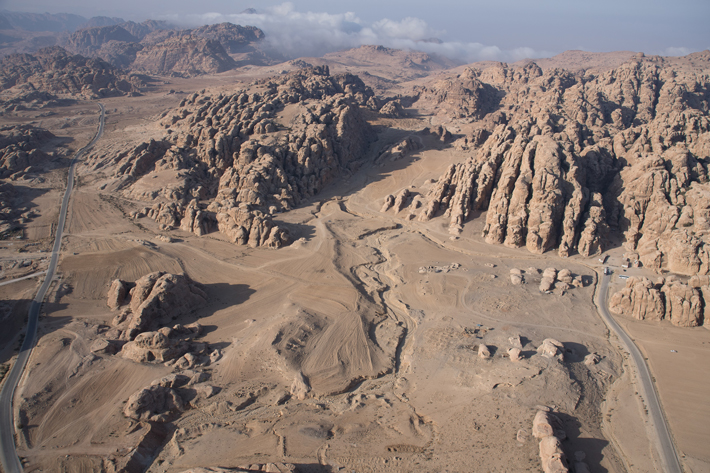 For more than two millennia, travelers, merchants, and scholars have been awed as they walked through a gorge in the desert of western Jordan to find themselves in a city carved almost entirely from red sandstone. Named Petra, meaning “rock,” by the Roman emperor Trajan in the second century A.D., the earliest city at the site dates to the second century B.C. At that time, the Nabataeans, a Semitic people whose origins are unclear, began building their grand capital, which, according to an inscription found there, they called Raqmu. The Nabataeans controlled the regional trade in gold, spices, and other luxury goods, which were transported between Gaza, with its access to the Mediterranean—and thus to the rich markets of Greece and Rome—and places as distant as India and China. Raqmu’s art, architecture, and lifestyle reflected the myriad cultural influences garnered from the Nabataeans’ trading relationships with the Persian, Greek, Roman, and Egyptian worlds. The city featured posh hilltop villas similar to those built by King Herod the Great of Judea, depictions of Greco-Roman deities such as Dionysus and Aphrodite, and stone columns topped with carved human heads, a tradition rooted in Middle Kingdom Egypt of the second millennium B.C. In an area with limited rainfall, the Nabataeans’ complex and difficult-to-maintain water management system spurred the city’s construction and its thriving local agricultural economy.
For more than two millennia, travelers, merchants, and scholars have been awed as they walked through a gorge in the desert of western Jordan to find themselves in a city carved almost entirely from red sandstone. Named Petra, meaning “rock,” by the Roman emperor Trajan in the second century A.D., the earliest city at the site dates to the second century B.C. At that time, the Nabataeans, a Semitic people whose origins are unclear, began building their grand capital, which, according to an inscription found there, they called Raqmu. The Nabataeans controlled the regional trade in gold, spices, and other luxury goods, which were transported between Gaza, with its access to the Mediterranean—and thus to the rich markets of Greece and Rome—and places as distant as India and China. Raqmu’s art, architecture, and lifestyle reflected the myriad cultural influences garnered from the Nabataeans’ trading relationships with the Persian, Greek, Roman, and Egyptian worlds. The city featured posh hilltop villas similar to those built by King Herod the Great of Judea, depictions of Greco-Roman deities such as Dionysus and Aphrodite, and stone columns topped with carved human heads, a tradition rooted in Middle Kingdom Egypt of the second millennium B.C. In an area with limited rainfall, the Nabataeans’ complex and difficult-to-maintain water management system spurred the city’s construction and its thriving local agricultural economy.
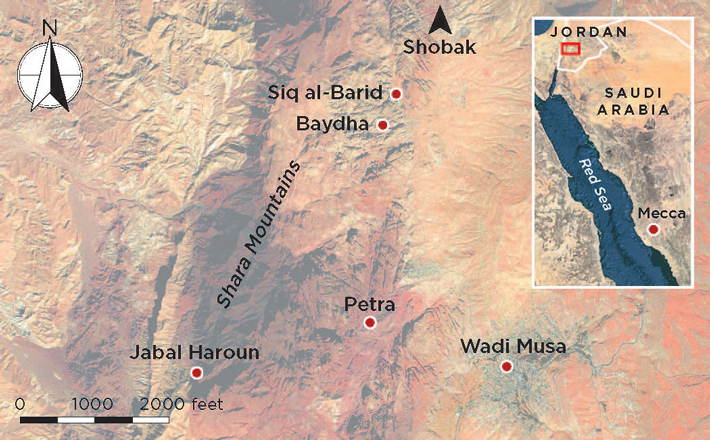 Although Raqmu’s reliance on its water system later proved to be one cause of its undoing, for several hundred years, the water supply supported fruit orchards and olive groves in the city center. The suburban areas were even more lush. An ancient settlement just east of Petra’s grand entrance, in what is now called Wadi Musa, had ready access to spring water and was home to dozens of olive trees and olive presses. Since the 1970s, archaeologists have discovered more than 30 rock-cut wine presses in Baydha, a settlement three miles north of Petra’s center. This evidence of intensive viniculture starting in the first century B.C., when the Nabataeans began to adopt cultural practices from the Greek world, including the consumption of wine, was an early indication that Baydha, although smaller and less architecturally magnificent than central Petra, was nevertheless an important part of the city’s history.
Although Raqmu’s reliance on its water system later proved to be one cause of its undoing, for several hundred years, the water supply supported fruit orchards and olive groves in the city center. The suburban areas were even more lush. An ancient settlement just east of Petra’s grand entrance, in what is now called Wadi Musa, had ready access to spring water and was home to dozens of olive trees and olive presses. Since the 1970s, archaeologists have discovered more than 30 rock-cut wine presses in Baydha, a settlement three miles north of Petra’s center. This evidence of intensive viniculture starting in the first century B.C., when the Nabataeans began to adopt cultural practices from the Greek world, including the consumption of wine, was an early indication that Baydha, although smaller and less architecturally magnificent than central Petra, was nevertheless an important part of the city’s history.
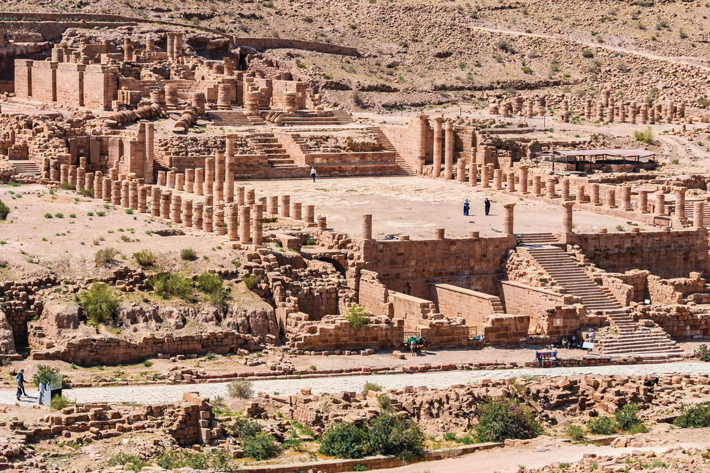 The Nabataean Kingdom, which controlled an area from the Arabian peninsula to Damascus, was at its height in A.D. 106, when Trajan (r. A.D. 98–117) annexed Petra. The era’s textual sources are mainly silent on the subject, but most scholars agree that the emperor likely encountered little resistance, and he soon made the area part of the new province of Arabia. Initially, Petra continued to benefit from trade under the Romans, the profits of which paid for urban improvement projects such as renovation of a public park and pool complex and construction of watchtowers. An increased number of farming terraces from that time indicate that the city’s residents also expanded their agricultural production, which helped support Petra’s growing population. In the mid-second century A.D., according to contemporaneous documents found in a cave on the western shore of the Dead Sea, the city was prominent enough to warrant visits from the provincial governor. But the main sources of Petra’s wealth and success would soon come to an end.
The Nabataean Kingdom, which controlled an area from the Arabian peninsula to Damascus, was at its height in A.D. 106, when Trajan (r. A.D. 98–117) annexed Petra. The era’s textual sources are mainly silent on the subject, but most scholars agree that the emperor likely encountered little resistance, and he soon made the area part of the new province of Arabia. Initially, Petra continued to benefit from trade under the Romans, the profits of which paid for urban improvement projects such as renovation of a public park and pool complex and construction of watchtowers. An increased number of farming terraces from that time indicate that the city’s residents also expanded their agricultural production, which helped support Petra’s growing population. In the mid-second century A.D., according to contemporaneous documents found in a cave on the western shore of the Dead Sea, the city was prominent enough to warrant visits from the provincial governor. But the main sources of Petra’s wealth and success would soon come to an end.
By the third century A.D., a shift in trade routes made the city obsolete, and references to it nearly cease in the historical record. The road from Petra to Gaza had fallen out of use, and historical sources, such as the writings of the historian Eusebius of Caesarea and accounts by Christian pilgrims, indicate that more goods from Asia and India were making their way west via southern sea routes or by a northern route through what is now Syria. At the same time, the demand for exotic eastern goods such as spices and perfumes plummeted as the Roman Empire experienced political turmoil and economic challenges brought on by numerous invasions and military engagements. Excavations at Petra have shown that there was a sharp decline in the number of ceramic vessels used to store cosmetic oils perfumed with ingredients from the East, a once-booming industry that had endured since Petra’s founding. Financial setbacks such as this, along with an A.D. 363 earthquake referred to in a letter written by a bishop of Jerusalem and widely visible in the site’s collapsed and damaged structures, led scholars to consider this period, for all intents and purposes, the end of Petra.
Archaeologists have excavated at Petra since the late nineteenth century, concentrating mostly on the rock-carved Nabataean tombs and shrines, and have paid less attention to other periods within the city or to its outskirts. “This has led to the narrative that Petra was abandoned after the Nabataeans,” explains archaeologist Micaela Sinibaldi, an honorary research fellow at Cardiff University. “But we now know that this is just not true. The later periods of Petra have simply been overlooked.” In fact, the full trajectory of the region’s cultural and religious history, from paganism to Christianity to Islam, is evident in the areas surrounding Petra.
Since 2014, Sinibaldi has directed the Islamic Baydha and Late Petra Projects. “It’s exciting because there is so much to discover about the later periods of Petra,” she says. “In Baydha, especially, there is the most significant and, at the same time, accessible evidence we have available for the Islamic period in the entire Petra region.” Because there is scarce evidence of a human presence in Petra after the sixth century A.D., the hinterlands have emerged as the key place to find out about these later centuries. “Baydha is a relatively small place, but it includes, for the most part, all the archaeological periods present in Petra and its environs,” Sinibaldi says. “Not very much was written in the historical accounts, but we do have the chance to make up for this with archaeology. It’s a matter of reconstructing several pages of history that we are missing.”
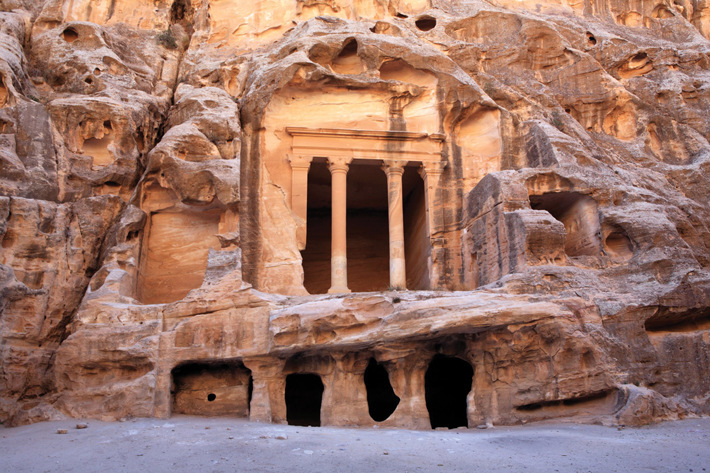
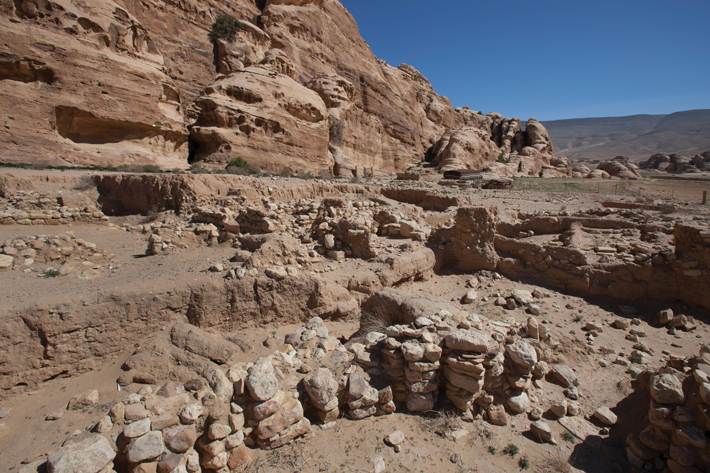 The settlement of Baydha includes Siq al-Barid, nicknamed “Little Petra,” a gorge filled with Nabataean carved tombs, dwellings, and dining areas similar to those found in the center of Petra. In the 1950s, British archaeologist Diana Kirkbride-Helbaek was among the first researchers to raise scholars’ interest in non-Nabataean settlement in and around the city. “By way of a change from things Nabataean, I used to explore the region on my free days looking for flint sites,” Kirkbride-Helbaek wrote in a 1968 article in the journal Antiquity. With the help of local Bedouin, she excavated Neolithic Baydha, where people settled more than 9,000 years ago. She found that they lived in a village of stone houses, cultivated grains such as wild wheat and barley, collected wild pistachio nuts, and raised goats. Kirkbride-Helbaek also studied some of the Nabataean remains and concluded that during their time the area had served as a sort of residential suburb and caravan station.
The settlement of Baydha includes Siq al-Barid, nicknamed “Little Petra,” a gorge filled with Nabataean carved tombs, dwellings, and dining areas similar to those found in the center of Petra. In the 1950s, British archaeologist Diana Kirkbride-Helbaek was among the first researchers to raise scholars’ interest in non-Nabataean settlement in and around the city. “By way of a change from things Nabataean, I used to explore the region on my free days looking for flint sites,” Kirkbride-Helbaek wrote in a 1968 article in the journal Antiquity. With the help of local Bedouin, she excavated Neolithic Baydha, where people settled more than 9,000 years ago. She found that they lived in a village of stone houses, cultivated grains such as wild wheat and barley, collected wild pistachio nuts, and raised goats. Kirkbride-Helbaek also studied some of the Nabataean remains and concluded that during their time the area had served as a sort of residential suburb and caravan station.
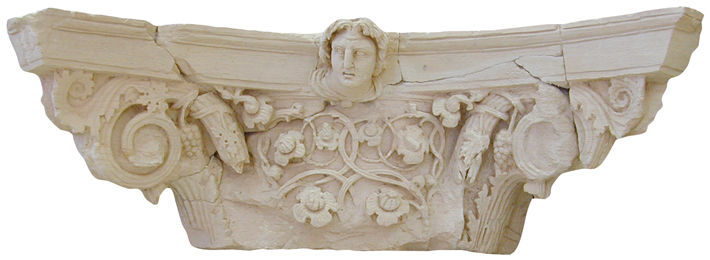 It was not until the 1990s, however, that the narrative of Petra’s post-Nabataean abandonment first started to be questioned, as archaeologists began to find later remains in both the city center and the surrounding areas. It had long been known that in the fourth century A.D., when the Byzantine, or Eastern Roman, Empire controlled the region, the city’s water management system fell into disrepair, explains Megan Perry, an anthropologist at East Carolina University and codirector of the North Ridge Project in Petra. This, along with the earthquake in the fourth century and another in the sixth, likely spurred many people to relocate to the countryside in search of easier access to water and richer soil. “The city became much less habitable,” Perry says. “But people didn’t disappear, they just gradually moved.” The people in the area were likely descendants of the Nabataeans who had been living there for generations. In fact, at least through the sixth century, much of the population kept their Semitic Nabataean names, despite the fact that the language they used was Greek, says archaeologist Laila Nehmé of the French National Center for Scientific Research. “People and languages don’t go away just because power changes,” she says.
It was not until the 1990s, however, that the narrative of Petra’s post-Nabataean abandonment first started to be questioned, as archaeologists began to find later remains in both the city center and the surrounding areas. It had long been known that in the fourth century A.D., when the Byzantine, or Eastern Roman, Empire controlled the region, the city’s water management system fell into disrepair, explains Megan Perry, an anthropologist at East Carolina University and codirector of the North Ridge Project in Petra. This, along with the earthquake in the fourth century and another in the sixth, likely spurred many people to relocate to the countryside in search of easier access to water and richer soil. “The city became much less habitable,” Perry says. “But people didn’t disappear, they just gradually moved.” The people in the area were likely descendants of the Nabataeans who had been living there for generations. In fact, at least through the sixth century, much of the population kept their Semitic Nabataean names, despite the fact that the language they used was Greek, says archaeologist Laila Nehmé of the French National Center for Scientific Research. “People and languages don’t go away just because power changes,” she says.
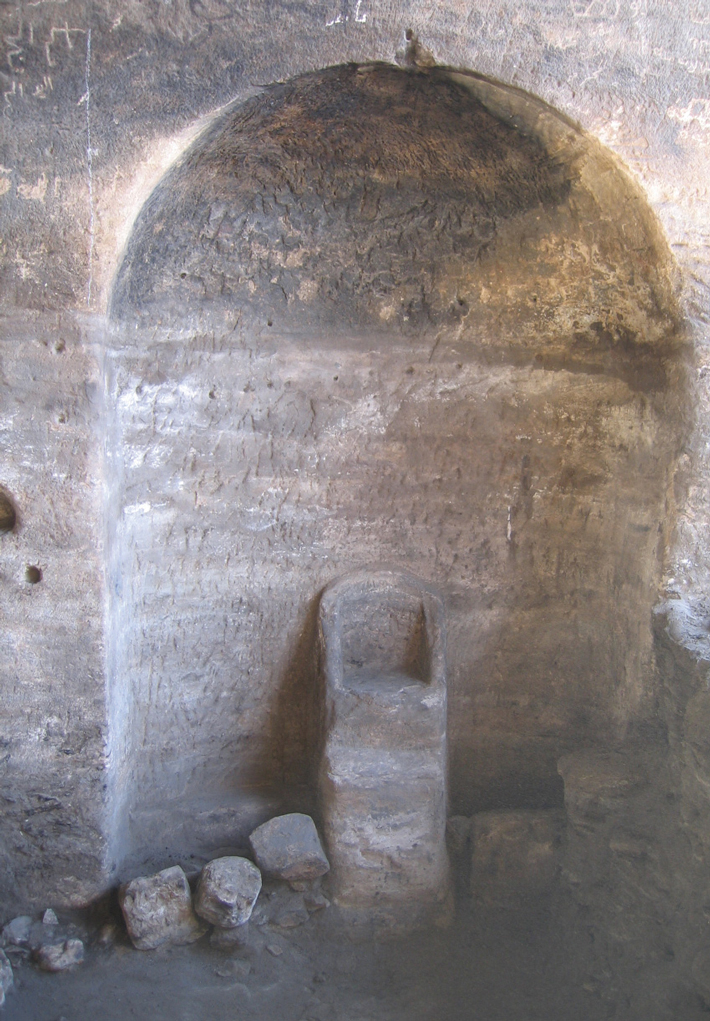 Under the Byzantine rulers, some inhabitants of Petra and its environs adopted Christianity, which had become the preferred, state-supported religion, despite their location far from the center of power in Constantinople. In the 1990s, Patricia Maynor Bikai, then assistant director the American Center of Oriental Research in Jordan, excavated three churches dating to the fifth and sixth centuries on a slope overlooking Petra’s main thoroughfare, as well as a bishop’s residence and a three-room building used for baptisms. Archaeologists have also found that, although the fourth-century earthquake destroyed many Nabataean shrines, some remained in use throughout the Byzantine period, evidence that Christianity had not completely replaced earlier religions. Even more evidence of post-Nabataean Petra began to emerge when Bikai carried out a survey of Baydha in the 2000s. She found that, in the fifth century, one of the Nabataean rock-cut communal halls had been transformed into a church with an apse, and a bishop’s chair had been carved into the rock wall. Bikai also discovered two mosques, thus far the only ones to have been found in this region, and about 100 dwellings that she suspected were from the Islamic period. “We had no idea they were there,” Bikai says. “It shows you don’t get a complete picture of what Petra was without exploring outside the city center.”
Under the Byzantine rulers, some inhabitants of Petra and its environs adopted Christianity, which had become the preferred, state-supported religion, despite their location far from the center of power in Constantinople. In the 1990s, Patricia Maynor Bikai, then assistant director the American Center of Oriental Research in Jordan, excavated three churches dating to the fifth and sixth centuries on a slope overlooking Petra’s main thoroughfare, as well as a bishop’s residence and a three-room building used for baptisms. Archaeologists have also found that, although the fourth-century earthquake destroyed many Nabataean shrines, some remained in use throughout the Byzantine period, evidence that Christianity had not completely replaced earlier religions. Even more evidence of post-Nabataean Petra began to emerge when Bikai carried out a survey of Baydha in the 2000s. She found that, in the fifth century, one of the Nabataean rock-cut communal halls had been transformed into a church with an apse, and a bishop’s chair had been carved into the rock wall. Bikai also discovered two mosques, thus far the only ones to have been found in this region, and about 100 dwellings that she suspected were from the Islamic period. “We had no idea they were there,” Bikai says. “It shows you don’t get a complete picture of what Petra was without exploring outside the city center.”
When the population of Petra and the surrounding region adopted Islam on a large scale is an open question. Arabic texts from the 630s refer to Muslim armies from the Arabian Peninsula arriving in the cities of Aqaba and Udruh, but do not contain any discussion of nearby Petra. “Either the armies didn’t take Petra because it was naturally protected,” says Nehmé, “or they didn’t think it was worth it.”
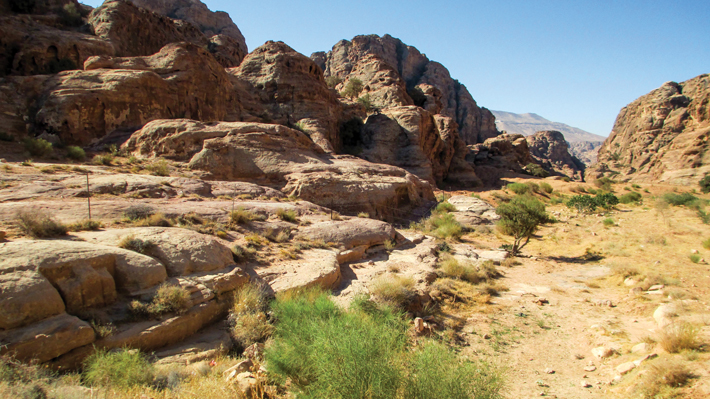 The earliest direct signs of Islam in Petra are seventh- and eighth-century Arabic inscriptions asking Allah for forgiveness. According to Zeyad al-Salameen, an archaeologist at Al-Hussein Bin Talal University, these inscriptions are similar in both language and script to other Islamic invocations from the period. While some of the local population continued to practice Christianity, how the rest adopted or viewed Islam is debated, with few archaeological findings and almost no textual references to help clarify the process. The absence of references to Petra in the historical record seems to indicate that the area was not especially important to most pre-twelfth-century Islamic rulers, who were based in far-off places such as Damascus, Baghdad, and North Africa. “Petra was on the fringes of Islamic areas of power,” Sinibaldi says. “Islamization there was gradual, and at least until the end of the twelfth century, the area was largely Christian.”
The earliest direct signs of Islam in Petra are seventh- and eighth-century Arabic inscriptions asking Allah for forgiveness. According to Zeyad al-Salameen, an archaeologist at Al-Hussein Bin Talal University, these inscriptions are similar in both language and script to other Islamic invocations from the period. While some of the local population continued to practice Christianity, how the rest adopted or viewed Islam is debated, with few archaeological findings and almost no textual references to help clarify the process. The absence of references to Petra in the historical record seems to indicate that the area was not especially important to most pre-twelfth-century Islamic rulers, who were based in far-off places such as Damascus, Baghdad, and North Africa. “Petra was on the fringes of Islamic areas of power,” Sinibaldi says. “Islamization there was gradual, and at least until the end of the twelfth century, the area was largely Christian.”
In addition to the paucity of historical records, for about 500 years, from the seventh through twelfth centuries, scant archaeological evidence of how people lived has been found in Petra or in nearby settlements such as Baydha. But Sinibaldi’s work comparing pottery sherds found in Baydha and Petra to those from better-dated excavations in the region revealed that there was not a significant gap in habitation throughout the region. The fertile soil, especially outside the city center, would have kept people living and farming there, she says. The Petra Valley was never completely abandoned, and, because there were rock-cut Nabataean structures available to use, the inhabitants weren’t required to build new dwellings.
The textual record picks up only slightly in the early twelfth century. Accounts include the Latin writings of the priest Fulcher of Chartres concerning European Crusader armies trying to gain a foothold in the Petra area as a means to control some regional trade and pilgrimage routes. The writings of Fulcher and others, including the medieval chronicler and archbishop William of Tyre, refer to the thriving local agriculture, especially in Wadi Musa, which they identify as the largest settlement in the area. Although the Crusaders built three forts in the area, which are still standing today, their occupation of Petra was over by the twelfth century. “Petra is more or less forgotten in the Islamic period,” Nehme says. For this reason, Sinibaldi was intrigued by the Islamic-period village and mosques that Bikai had discovered.
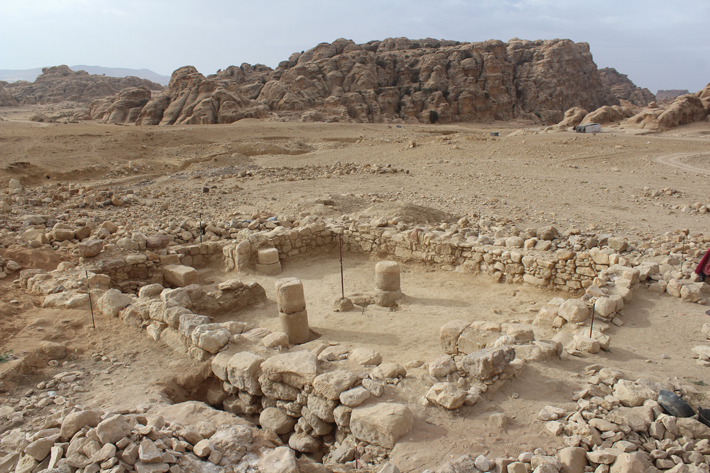
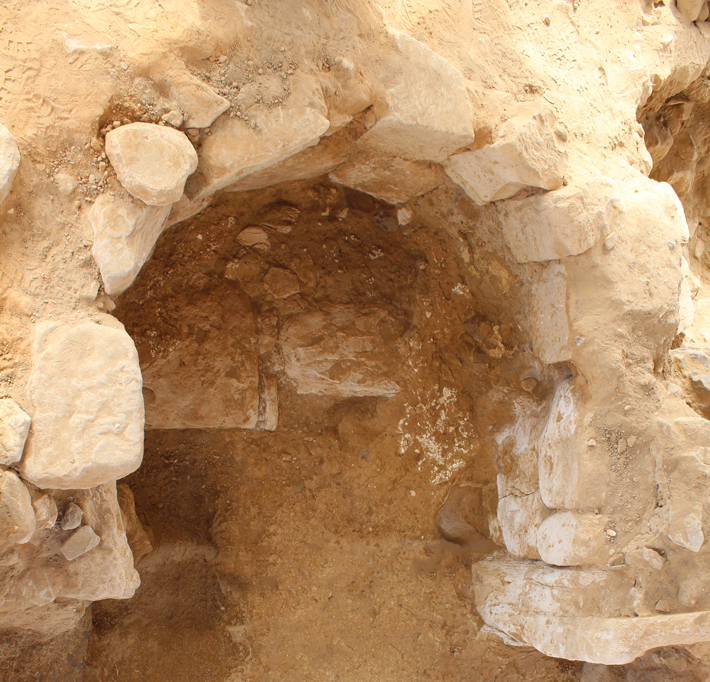
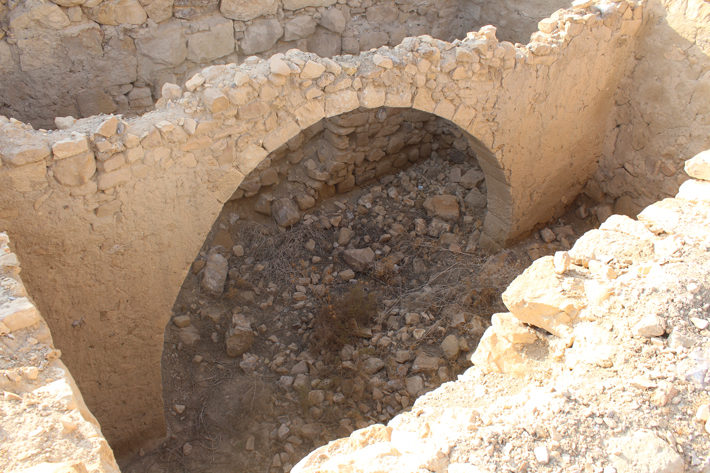 At first, the dating of the mosques and surrounding homes was uncertain. But then, Sinibaldi’s team discovered a fourteenth-century Egyptian coin in a tabun, or domed oven, that dated one of the houses to the period when the Mamluks, who were originally Turkish military slaves, ruled much of the Middle East from their seat in Cairo. They also had a base at nearby Shobak Castle, which had been built by the Crusaders. Each mosque was built on the foundation of a Nabataean residential building with a dirt floor, stone arch, and wooden roof. The highest-quality stones from earlier Nabataean buildings were used for the mihrab, or prayer niche. Each structure could have held about 40 or 50 people, suggesting to Sinibaldi that, assuming most grown men attended prayers, about 400 people lived in the village at the time. At some point, an earthquake demolished the building. “I think the later mosque may actually be a replacement for the first, destroyed mosque,” Sinibaldi says. Inside the second mosque, she found traces of the people who once prayed there, including an oil lamp, an earring, a ring, and a board game that resembles tic-tac-toe. Because her team did not find any pottery, coins, or other precisely datable artifacts inside either mosque, Sinibaldi hopes that radiocarbon dating of juniper wood used to build the roof will help confirm their construction dates. Although the glory of the Nabataean Kingdom and of Roman Petra had long ago faded, and this stretch of desert highlands was no longer part of the lucrative global trade routes that had once enriched it, the construction of the mosques provides clear evidence that the region was still populated, and that it had undergone at least a partial religious and cultural transformation to Islam.
At first, the dating of the mosques and surrounding homes was uncertain. But then, Sinibaldi’s team discovered a fourteenth-century Egyptian coin in a tabun, or domed oven, that dated one of the houses to the period when the Mamluks, who were originally Turkish military slaves, ruled much of the Middle East from their seat in Cairo. They also had a base at nearby Shobak Castle, which had been built by the Crusaders. Each mosque was built on the foundation of a Nabataean residential building with a dirt floor, stone arch, and wooden roof. The highest-quality stones from earlier Nabataean buildings were used for the mihrab, or prayer niche. Each structure could have held about 40 or 50 people, suggesting to Sinibaldi that, assuming most grown men attended prayers, about 400 people lived in the village at the time. At some point, an earthquake demolished the building. “I think the later mosque may actually be a replacement for the first, destroyed mosque,” Sinibaldi says. Inside the second mosque, she found traces of the people who once prayed there, including an oil lamp, an earring, a ring, and a board game that resembles tic-tac-toe. Because her team did not find any pottery, coins, or other precisely datable artifacts inside either mosque, Sinibaldi hopes that radiocarbon dating of juniper wood used to build the roof will help confirm their construction dates. Although the glory of the Nabataean Kingdom and of Roman Petra had long ago faded, and this stretch of desert highlands was no longer part of the lucrative global trade routes that had once enriched it, the construction of the mosques provides clear evidence that the region was still populated, and that it had undergone at least a partial religious and cultural transformation to Islam.
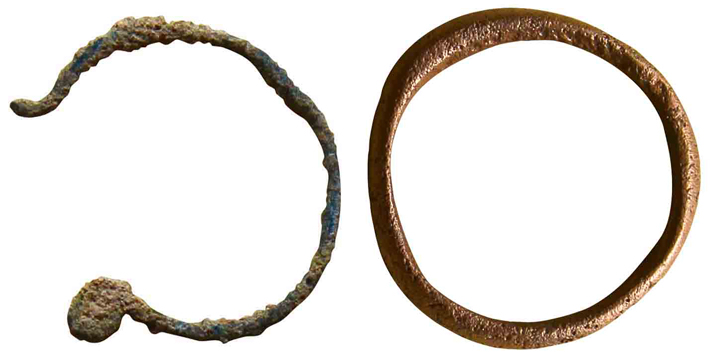 Sinibaldi attributes the increased population of Baydha during the Mamluk period to the rise in popularity of nearby Islamic pilgrimage routes. The Mamluks, and later the Ottomans, promoted pilgrimages not only to the holy city of Mecca, but also to burial sites of prophets and saints, she explains. And it was Baydha that profited as a result of this practice. Baydha was only about a day’s walk from Shobak, an important stop for both merchants and pilgrims on the route to Mecca from Egypt and the Mediterranean. It was also just three miles from Jabal Haroun, a mountaintop revered as the resting place of the prophet Aaron, who is mentioned in both the Hebrew Bible and the Koran. “Baydha was a relatively well-connected place,” says archaeologist Alex Knodell of Carleton College, former field director of the Brown University Petra Archaeological Project, whose extensive survey uncovered a large amount of ceramic evidence from the late Islamic era there. Sinibaldi’s team has excavated one of the Mamluk-period houses in the village. Most of the excavated houses’ courtyards contain dome-shaped stone tabun ovens, which also closely resemble those used in modern times. “What is most striking,” Sinibaldi says, “is that the building style doesn’t differ much from what we see today in this region.”
Sinibaldi attributes the increased population of Baydha during the Mamluk period to the rise in popularity of nearby Islamic pilgrimage routes. The Mamluks, and later the Ottomans, promoted pilgrimages not only to the holy city of Mecca, but also to burial sites of prophets and saints, she explains. And it was Baydha that profited as a result of this practice. Baydha was only about a day’s walk from Shobak, an important stop for both merchants and pilgrims on the route to Mecca from Egypt and the Mediterranean. It was also just three miles from Jabal Haroun, a mountaintop revered as the resting place of the prophet Aaron, who is mentioned in both the Hebrew Bible and the Koran. “Baydha was a relatively well-connected place,” says archaeologist Alex Knodell of Carleton College, former field director of the Brown University Petra Archaeological Project, whose extensive survey uncovered a large amount of ceramic evidence from the late Islamic era there. Sinibaldi’s team has excavated one of the Mamluk-period houses in the village. Most of the excavated houses’ courtyards contain dome-shaped stone tabun ovens, which also closely resemble those used in modern times. “What is most striking,” Sinibaldi says, “is that the building style doesn’t differ much from what we see today in this region.”
Baydha ultimately outlasted the grand city of Petra, surviving into the Middle Ages and beyond. People built their houses and mosques in Baydha, rather than among the captivating red and pink rock-carved Nabataean buildings in Petra, mainly because access to water was so much easier. The same soil that absorbed the rains coming down the Shara Mountains that attracted people there 9,000 years ago continued to sustain Baydha long after Petra’s water systems had failed and people were gone. “There’s a lot of history in this small place,” Sinibaldi says. “It’s important to understand that history is not just made in big centers.”
Sara Toth Stub is a journalist living in Jerusalem.
from Hacker News https://ift.tt/2pCcVPm
No comments:
Post a Comment
Note: Only a member of this blog may post a comment.